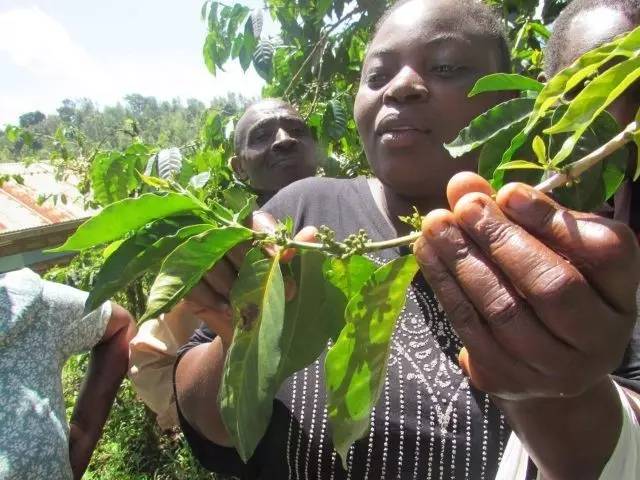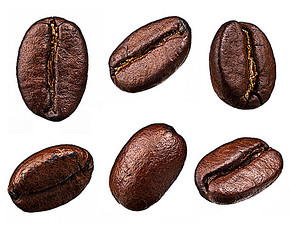Introduction to the Core process of Coffee extraction principle
Follow the caf é (Wechat official account vdailycom) and found that Beautiful Cafe opened a small shop of its own.
What is the appropriate temperature for coffee extraction?
1. Let's start with the problem itself, no matter whether we make hand brew, siphon, or espresso. If you have attended a training course, you will always mention the problems of insufficient extraction and excessive extraction. In simple words:
Insufficient extraction means that the flavor of coffee is not fully extracted by water. At this time, if it is espresso, the color will be lighter and sour.
When the extraction is insufficient, the taste is often sour.
Coffee is excessively extracted, that is, the flavor of coffee is excessively extracted by water, which is mixed, bitter and even scorched.
If you extract too much, it tends to taste bitter.

2. Coffee extraction is over-water, so the higher the water temperature is, the more flavor will be extracted. Therefore, excessive temperature may lead to excessive extraction (of course, there are other reasons).
On the contrary, if the temperature is too low and the flavor intake is not enough, the extraction will be insufficient.
The fresher the coffee is, the more flavor it will contain. The longer the coffee is kept, the less flavor it will contain.
The conclusion is that the fresher the coffee is, the lower the temperature is because you don't want to extract the excessive flavor. The less fresh the coffee is, the higher the temperature will be, because a higher temperature is needed to increase the solubility of the water to absorb the retained flavor.
For example, espresso often takes about a week to wake up, and the coffee extraction temperature is often about 92 °a week later. If it has been placed for more than 3 months, it will often be 96 °.
The core process of extraction principle
1. Grind coffee beans to increase the surface area of coffee in contact with water.
2. Coffee powder is fully soaked in aqueous solution, and coffee essence is hydrophilic dissolved.
3. Separate coffee solution and coffee grounds.
All modern coffee extraction is the two core processes of soaking and filtration, which belongs to the category of physics, and there is basically no chemical change in the process. The differences in the thickness of coffee powder, the length of soaking time, the method of separation and filtration, and so on, have created a wealth of coffee brewing utensils and techniques.
Although the core process of coffee extraction is the same, according to the significant differences in pressure and time used in coffee extraction, modern coffee extraction methods can be simply divided into two types:
1: Italian Fast espresso (Espresso)
Espresso extracts 30 milliliters of espresso in 22s-27s seconds at 9 atmospheric pressure and 88 °C / 95 °C water temperature. This is significantly different from other coffee extraction methods, which can be done under unnatural conditions, reflecting the intervention of science and technology.
Espresso Espresso can generally be made by Italian semi-automatic coffee machine and full-automatic coffee machine. A good Espresso requires higher price and quality of coffee machine and bean grinder.
2: immersion extraction (Steep Extraction)
It is a traditional, natural and simple way of coffee extraction; the extraction temperature is close to 85-92 and the filtration pressure is about 1 atmospheric pressure. It can be subdivided into:
Pressure filtration:
Use artificial pressure to filter coffee, including French press (French coffee cup French Press) and Philharmonic pressure AeroPress
Siphon:
Use the pressure difference caused by steam cooling to filter coffee, including siphon coffee maker Syphon, Belgian coffee maker
Drip filtration:
Natural gravity drip filter coffee, including American electric drip filter coffee maker, Vietnamese drip filter coffee maker, Swiss gold Swissgold kf-300 drip filter coffee maker, hand filter module, ice drip coffee maker, etc.
Steam pressurization:
Italian mocha pot Moka, many manufacturers also claim that mocha pots can make Espresso for commercial interests, but the coffee made by early mocha pots is essentially different from modern Espresso coffee. The pressure of mocha pots is only more than 1: 00 atmospheric pressure, and the pressure and final coffee extraction time may not be as fast as siphon coffee pots. According to performance indicators, we still classify mocha pots as natural traditional soaking extraction Steep Extraction.
Important Notice :
前街咖啡 FrontStreet Coffee has moved to new addredd:
FrontStreet Coffee Address: 315,Donghua East Road,GuangZhou
Tel:020 38364473
- Prev

Flavor roasting and production of Kenyan coffee beans
Following Cafe Review (Wechat official account vdailycom) found that Beautiful Caf é opened a small shop of its own. Almost all boutique cafes serve Kenyan coffee, and almost all boutique coffee roasters roast Kenyan coffee, which is famous all over the world. Why is that? We need to know more about Kenyan coffee. Kenyan coffee flavor complex / complexity
- Next

Why is coffee the perfect companion for weight loss?
Following Cafe Review (official Wechat account vdailycom) found that Beautiful Cafe opened a small shop of its own and scientists have found a reason for drinking coffee every day, that is: coffee helps keep fit and improve weight loss! In The Coffee Lovers Diet, a new book by health expert and journalist Bob Arnot, the author reveals how much coffee is consumed
Related
- Beginners will see the "Coffee pull flower" guide!
- What is the difference between ice blog purified milk and ordinary milk coffee?
- Why is the Philippines the largest producer of crops in Liberia?
- For coffee extraction, should the fine powder be retained?
- How does extracted espresso fill pressed powder? How much strength does it take to press the powder?
- How to make jasmine cold extract coffee? Is the jasmine + latte good?
- Will this little toy really make the coffee taste better? How does Lily Drip affect coffee extraction?
- Will the action of slapping the filter cup also affect coffee extraction?
- What's the difference between powder-to-water ratio and powder-to-liquid ratio?
- What is the Ethiopian local species? What does it have to do with Heirloom native species?

